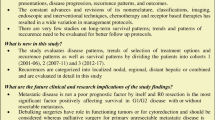Summary
Neuroendocrine tumors (NET) are rare tumors for which somatostatin analogs (SSA) are used not only for symptom control due to a functioning tumor, but also for the disease control of unresectable NET. The efficacy of SSA for midgut NET has been verified by previous studies, but insufficient evidence exists for SSA treatment of NET in the foregut and hindgut (F/H-NET). The aim of this retrospective study was to evaluate the efficacy of SSA for unresectable F/H-NET. Patients with unresectable F/H-NET treated with SSA between February 2011 and August 2017 at our hospital were retrospectively reviewed. Parameters of efficacy were progression-free survival (PFS), overall survival, objective response rate (ORR), and adverse events. Twelve cases with unresectable F/H-NET were extracted from our database. With a median follow-up time of 25.9 months, the median PFS was 13.6 months. Two- and 3-year survival rates were 87.5 and 62.5%, respectively. The ORR was 8.3%, and the disease control rate was 75%. Serious adverse events were not observed. Subgroup analysis, including G1/G2, and hepatic tumor load, which is the volume of NET liver metastases, did not reveal a difference in PFS. The efficacy and safety of SSA for F/H-NET seemed similar to that found in the PROMID study, highlighting its relevance for the treatment of this disease.



Similar content being viewed by others
References
Ito T, Igarashi H, Nakamura K, Sasano H, Okusaka T, Takano K, Komoto I, Tanaka M, Imamura M, Jensen RT, Takayanagi R, Shimatsu A (2015) Epidemiological trends of pancreatic and gastrointestinal neuroendocrine tumors in Japan: a nationwide survey analysis. J Gastroenterol 50:58–64
Yao JC, Hassan M, Phan A, Dagohoy C, Leary C, Mares JE, Abdalla EK, Fleming JB, Vauthey JN, Rashid A, Evans DB (2008) One hundred years after “carcinoid”: epidemiology of and prognostic factors for neuroendocrine tumours in 35,825 cases in the United States. J Clin Oncol 26:3063–3072
Rinke A, Müller HH, Schade-Brittinger C, Klose KJ, Barth P, Wied M, Mayer C, Aminossadati B, Pape UF, Bläker M, Harder J, Arnold C, Gress T, Arnold R (2009) Placebo-controlled, double-blind, prospective, randomized study on the effect of octreotide LAR in the control of tumor growth in patients with metastatic neuroendocrine midgut tumors: a report from the PROMID study group. J Clin Oncol 27:4656–4663
Caplin ME, Pavel M, Ćwikła JB, Phan AT, Raderer M, Sedláčková E, Cadiot G, Wolin EM, Capdevila J, Wall L, Rindi G, Langley A, Martinez S, Blumberg J, Ruszniewski P (2014) Lanreotide in metastatic enteropancreatic neuroendocrine tumors. N Engl J Med 371:224–233
Delle Fave G, O’Toole D, Sundin A et al (2016) ENETS consensus guidelines update for gastroduodenal neuroendocrine neoplasms. Neuroendocrinology 103:119–124 Accessed 12, April 2018
Kanda Y (2013) Investigation of the freely available easy-to-use software ‘EZR’ for medical statistics. Bone Marrow Transplant 48:452–458
Ito T, Honma Y, Hijioka S, Kudo A, Fukutomi A, Nozaki A, Kimura Y, Motoi F, Isayama H, Komoto I, Hisamatsu S, Nakajima A, Shimatsu A (2017) Phase II study of lanreotide autogel in Japanese patients with unresectable or metastatic well-differentiated neuroendocrine tumors. Invest. New Drugs 35:499–508
Kim ST, Ha SY, Lee J, Hong SN, Chang DK, Kim YH, Park YA, Huh JW, Cho YB, Yun SH, Lee WY, Kim HC, Park YS (2016) The clinicopathologic features and treatment of 607 hindgut neuroendocrine tumor (NET) patients at a single institution. Medicine (Baltimore) 95(19):e3534
Okubo Y, Motohashi O, Nakayama N, Nishimura K, Kasajima R, Miyagi Y, Shiozawa M, Yoshioka E, Suzuki M, Washimi K, Kawachi K, Nito M, Kameda Y, Yokose T (2016) The clinicopathological significance of angiogenesis in hindgut neuroendocrine tumors obtained via an endoscopic procedure. Diagn Pathol 11(1):128
Okubo Y, Kasajima R, Suzuki M, Miyagi Y, Motohashi O, Shiozawa M, Yoshioka E, Washimi K, Kawachi K, Kameda Y, Yokose T (2017) Risk factors associated with the progression and metastases of hindgut neuroendocrine tumors: a retrospective study. BMC Cancer 17:769
National Comprehensive Cancer Network Guidelines for Neuroendocrine Tumors Version 3.2017. https://www.nccn.org/professionals/physician_gls/pdf/neuroendocrine.pdf. Accessed 12, April 2018
Guidelines for pancreatic and gastroenteric neuroendocrine tumors Version 1.1 2015 http://jnets.umin.jp/pdf/guideline001_1s.pdf. Accessed 12, April 2018
Dasari A, Shen C, Halperin D, Zhao B, Zhou S, Xu Y, Shih T, Yao JC (2017) Trends in the incidence, prevalence, and survival outcomes in patients with neuroendocrine tumors in the United States. JAMA Oncol 3:1335–1342
Singh S, Carnaghi C, Buzzoni R, Pommier RF, Raderer M, Tomasek J, Lahner H, Valle JW, Voi M, Bubuteishvili-Pacaud L, Lincy J, Wolin E, Okita N, Libutti SK, Oh DY, Kulke M, Strosberg J, Yao JC, Pavel ME, Fazio N, for the RAD001 in Advanced Neuroendocrine Tumors, Fourth Trial (RADIANT-4) Study Group (2018) Everolimus in neuroendocrine tumors of the gastrointestinal tract and unknown primary. Neuroendocrinology 106(3):211–220
Yao JC, Phan AT, Chang DZ, Wolff RA, Hess K, Gupta S, Jacobs C, Mares JE, Landgraf AN, Rashid A, Meric-Bernstam F (2008) Efficacy of RAD001 (everolimus) and octreotide LAR in advanced low- to intermediate-grade neuroendocrine tumors: results of a phase II trial. J Clin Oncol 26:4311–4318
Acknowledgements
We thank all investigators and patients who participated in this study. The authors thank Ms. Emiko Usami for data collection.
Author information
Authors and Affiliations
Corresponding author
Ethics declarations
Conflict of interest
All authors do not have potential conflicts of interest to disclose.
Ethical approval
All procedures performed in studies involving human participants were in accordance with the ethical standards of the institutional and/or national research committee and with the 1964 Helsinki Declaration and its later amendments or comparable ethical standards. This retrospective study was approved by the Institutional Review Board of NCCH (2017–229).
Informed consent
For this type of study formal consent is not required.
Rights and permissions
About this article
Cite this article
Ida, H., Honma, Y., Hirano, H. et al. Clinical outcomes of patients with G1/G2 neuroendocrine tumors arising from foregut or hindgut treated with somatostatin analogs: a retrospective study. Invest New Drugs 37, 573–578 (2019). https://doi.org/10.1007/s10637-018-0669-7
Received:
Accepted:
Published:
Issue Date:
DOI: https://doi.org/10.1007/s10637-018-0669-7




